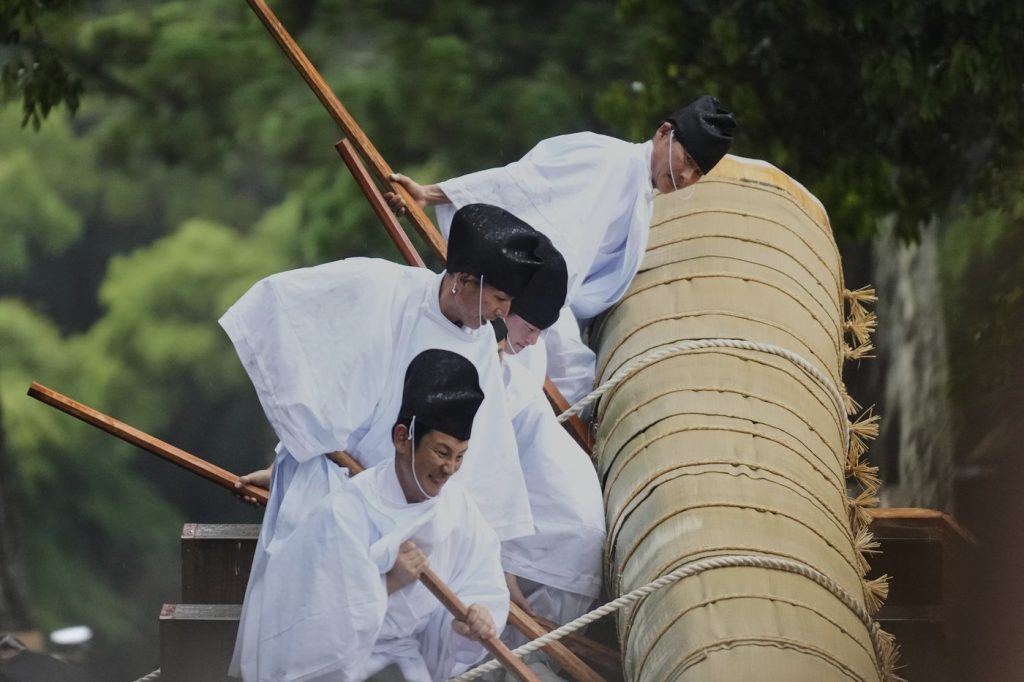Ise Jingu, located in Ise, Japan, stands as the most venerated Shinto shrine, engaging in a traditional and ritualistic rebuilding every 20 years. This monumental effort has been practiced for over 1,300 years, symbolizing the dynamic nature of Japanese spirituality and craftsmanship. The most recent cycle of this grand undertaking was concluded in 2013, and the year 2025 marks the commencement of the latest Shikinen Sengu process, which is currently being chronicled by journalists from The Associated Press.
The Shikinen Sengu ritual involves immense preparation, including the collection and processing of over 10,000 cypress trees, which are essential for constructing the new shrine buildings. This extensive project not only aims to maintain the physical structure of the shrine but also to honor the deities associated with it. Each phase of Shikinen Sengu includes more than 30 ceremonies and festivities that serve as cultural touchstones for the community. The culmination of this process will occur during a significant ceremony in 2033, when the presiding deity will be ceremonially transferred from the old shrine to the new one.
The celebrations associated with Shikinen Sengu not only reinforce community ties but also highlight Japan’s intricate art and religious traditions. For instance, on June 10, 2025, the Mihishirogi Hoeishiki ceremony was held, where members of the Shinto priesthood participated in the ritual of pushing down sacred timber from a wheeled platform, signifying the dismantlement of old structures in preparation for rebuilding.
On May 2, 2025, the Yamaguchisai kickoff ceremony was performed at Kotaijingu, the inner sanctuary of the Ise Jingu shrine complex. This event featured priests and Shinto officials marching in organized procession, a spectacle showcasing the deep spiritual reverence embedded in Japanese culture. The ceremonies are not merely formalities but are imbued with a sense of community participation and spiritual acknowledgment.
A crucial aspect of the Shikinen Sengu ritual involves the careful felling of cypress trees in the Akasawa national forest, an effort initiated during the Misomahajimesai ceremony on June 3, 2025. Workers meticulously harvested these sacred trees, which are essential for the altar and building structures of the Ise Jingu shrine. This step exemplifies the blend of nature and spirituality, where each timber used in the structure symbolizes a connection to the divine.
The crafting of elements for the shrine is equally significant. For instance, artisans at the Miyachu factory in Tamaki, central Japan, are dedicated to creating miniature replicas of the Ise Jingu shrine, alongside producing altar components. This craftsmanship preserves the traditional techniques passed down through generations, underscoring the commitment to art in maintaining cultural heritage.
Gatherings and local festivities are woven into the fabric of the Shikinen Sengu ritual, as seen in the community celebrations following the felling of sacred timbers on June 4, 2025. Participants were seen pulling these heavy logs in a festive procession, embodying the spirit of collaboration and celebration that accompanies this venerable tradition. Additionally, visual representations of participants engaging in traditional dances during the Mihishirogi Hoeishiki ceremony on June 9, 2025, reveal a vibrant cultural scene that thrives alongside religious observance.
In summary, the reconstruction of Ise Jingu is a profound ritual of renewal that encompasses spiritual, artistic, and communal elements. From the initial felling of trees to the meticulous ceremonies leading up to the deity transfer in 2033, every part of this process reflects a deep respect for tradition and an enduring commitment to sustaining Japan's cultural heritage.










